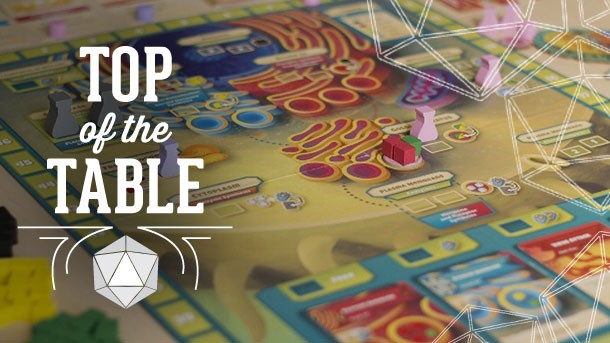Please support Game Informer. Print magazine subscriptions are less than $2 per issue
Top Of The Table – Stellar Board Games That Actually Teach

The educational game scene likely deserves some of the criticism that gets leveled its way. Taking a bunch of facts and jamming them into a tired trivia or card game format isn’t good game design, and whether your potential players are kids or adults, they’re sure to see through the ruse. Fortunately, recent years have seen a surge of excellent releases that treat educational elements like any other potential theme, and build a great design around that concept.
If you’re a teacher or parent, the games below are ideal for young people who learn best with supplementary game experiences. But in choosing the titles to select for this article, I’ve also tried hard to only include games that I’d happily recommend to any adult gaming group as well – stuff that is fun enough to come out on any game night.
I’ve also steered away from the wealth of clever releases that teach in an abstract way about strategic thinking, logic, or critical thinking; while those skills are eminently valuable to anyone, the focus here is on games with discrete subject themes like math or history.
Editor's Note: This article originally ran on March 23, 2018. We're resurfacing the article today for families who may be looking for additional opportunities and activities for kids currently sheltering in place at home.

Photosynthesis
Publisher: Blue Orange Games
Recommended age: 8+
Applicable subjects: Ecology, Life Science, Environmentalism
Selected as one of our best tabletop games of 2017, Photosynthesis is a phenomenal game about growing a forest. Two to four players each take on the role of a specific type of tree, like blue spruce or oak. Small trees can grow into towering behemoths that cast shadows across the rest of the forest. The unique hook is the ever-moving sun, represented by a game piece that rotates around the board to communicate the passing seasons, demanding that you consider how shade is cast from multiple perspectives over time. The growing table tableau is beautiful, filled with multi-colored cardboard trees of various sizes, each competing for light and life.
Players learn the principles about how plants use light to grow, the ways trees compete for placement in a crowded canopy, and showcases how a tree’s completed life cycle makes way for new life. The game also offers remarkably challenging tactical dilemmas, as tree placement must be considered from multiple perspectives simultaneously.

Timeline
Publisher: Asmodee
Recommended age: 10+
Applicable subjects: History, Cultural Studies
Proving that you probably know less than you think about the order that important historical moments happened, the aptly named Timeline challenges players to put major benchmarks in order. Every player has a hand of cards with specific instances to consider. It’s easy enough to know whether the domestication of sheep happened before the first 45 rpm record. But how about the invention of the pull-tab can or the typewriter?
Timeline is expandable and combinable across several subject areas, including Music & Cinema, American History, Americana, Events, and Inventions. It makes for a great family game, as adults and kids alike encounter subjects they know more or less about; inevitably, played cards elicit longer conversations about the historical moment in question, and why they were important. Played with adult friends, I think you’ll be surprised how frequently you’ll be off the mark. As a special note, while players under age 10 will have trouble having the necessary historical context to succeed, the simple core game mechanic is easy to grasp for a younger player, especially with help from an adult.
In addition to standard card packs for Timeline (which easily supports anywhere from two to eight players), you can also expand into the more fully-featured Timeline Challenge board game, or branch off into the similar Cardline series of games, which focuses on individual topics like animals, geography, and dinosaurs, and challenges players to compare and contrast them side by side.

Cytosis: A Cell Biology Game
Publisher: Genius Games
Recommended age: 10+
Applicable subjects: Biology, Physiology, Health
Genius Games is built around educational games (and books) that tackle a variety of subjects, and teachers and parents would be well advised to check out the company’s full catalog. But I’m especially impressed with Cytosis, a game all about living cells for two to five players. Immaculately presented and modeled scientific concepts like cell detoxification and the role of the mitochondria are all communicated seamlessly through the natural flow of the game. But strip away the science jargon, and Cytosis is a remarkably fun worker placement game. By placing tokens on various organelles on a board that represents a cell, different tasks may be completed like building enzymes and hormones, with the end goal of completing particular objectives and scoring health points to win the game.
I’ve rarely encountered a game that so aptly communicates complex topics through the DNA (no pun intended) of the game’s mechanics and structure. Cytosis also includes relevant details about the actual science behind the game and its presentation. Cytosis is a surprising, and at times highly competitive, experience that stands quite strong even before considering what might be learned along the way.

Ticket To Ride
Publisher: Days of Wonder
Recommended age: 8+
Applicable subjects: Geography
Two to five players can enjoy any one of the many variations of this classic and widely popular board game. In the original version, players are competing to claim various train routes across North America. Different routes demand a designated number of cards to connect two cities. Ticket to Ride is widely cited as one of the best “gateway games” into more involved thematic board games, and for good reason; its elegant rules are straightforward and quick-to-learn, but have the depth and replayability to keep players coming back.
And that’s one big reason why Ticket to Ride’s teaching of fundamental world geography is so great. By its very nature, players must carefully examine individual cities, and learn not only their locations, but also which cities they sit in close proximity. While the core game tackles North America, versions of the game exist for India, Europe, Africa, and several other locations. If the core concept is a hit with your gaming group, family, or classroom, there are tons of ways to expand the fun and learning potential. Regardless of version, Ticket to Ride supports 2-5 players.

Bananagrams
Publisher: Bananagrams
Recommended age: 7+
Applicable subjects: Spelling, Vocabulary, English, Foreign Language (with relevant version)
Of all the games on this list, this is probably the one you’ve likely already seen once or twice before. Bananagrams is a popular choice in the family game sphere, and it’s that way for a reason. The simple rules and focus on speed is attractive to both children and adults, and the game is ideal for developing vocabulary, spelling skills, and understanding the similarities between different words.
Players receive a set of tiles, with which they must create a freeform crossword-like grid of real words. As new tiles come into play, players are forced to rearrange their grid to accommodate the new letters. The focus is on making your grid of words as quickly as possible.
Bananagrams is simpler to play and speedier to complete than the similarly structured Scrabble, and is likely a better choice for word play with kids than that classic (but don’t get me wrong, Scrabble is great fun). And while the version you’ve likely seen helps build language skills in English, the game is also available in French, German, Hebrew, Icelandic, Italian, Norwegian, and Spanish options, and can be enjoyed by one to as many as eight players.

Concept
Publisher: Repos Production
Recommended age: 10+
Applicable subjects: Psychology, Linguistics
This is a fantastic party game for friends and family who might enjoy examining language and ideas from new perspectives. My experience with Concept is that it often starts with a few people at a get-together and everyone following turn order, but rapidly gathers other people at the party, until you have a crowd, and everyone is taking turns willy-nilly. With that said, it can also be enjoyed by smaller groups in equal measure as a more structured experience. As you’ll see if you decide to play, there’s no real player limit here, other than how many people can fit around the table and see the board.
A large board depicts a variety of concepts core to how we organize our thoughts. These schema are represented as images, not words, so it’s up to the players to decide exactly how they interpret each picture. One or two players play tokens onto chosen spaces that represent a concept. For instance, a simple one might be an animal that is also small, yellow, black, and flies – pretty soon, the other players are able to guess that you might be talking about a bee. But what images might you use for a concept like “Tina Turner,” or “Hungry like the Wolf?”
I love the way this game reveals the way we all understand language and communication, as well as the psychology behind shared understanding of core ideas once written and spoken language has been stripped away.
A special note about the age range on this one: The game suggests players of 10 years and older, but I suspect that has more to do with the clues on the cards than anything else. With easy tweaking, you can alter the concepts that players are presenting and transform them into ideas that younger children can grasp; I had a blast playing with a six-year old nephew, and also got some surprising insight into how he organizes his thoughts.

Dice Stars
Publisher: WizKids
Recommended age: 10+
Applicable subjects: Math
I didn’t want to finish out our list without a couple of fun math games. Lots of great games teach logical thinking, pattern recognition, and there are even building games that show off geometric and engineering principles. However, for a straightforward numbers-based arithmetic game that is also a ton of fun, I’ll first point you toward Dice Stars. This quick-playing abstract dice game is loosely themed around falling stars, but it’s really about numbers, sets, addition, and multiplication.
Players roll dice into a shared pool, and then select specific dice to mark onto an included scoring grid sheet (the game includes a pad with a bunch of sheets, and more are printable online). Same numbered or colored dice in the same row or column can be added together, but collect enough star results and you’ll eventually score a multiplication of the row.
Dice Stars has some simple arithmetic to complete, but its more significant mathematical depth comes through thinking ahead and understanding the probabilities of different die results, and then making smart choices about what rows and columns to pursue on your scoring sheet, pushing your luck as you pursue different matched sets. Up to four players can hop in and enjoy Dice Stars in a single game, but there’s also a fun solitaire mode for solo players.

Prime Climb
Publisher: Math For Love
Recommended age: 10+
Applicable subjects: Math
This highly replayable and enjoyable competitive game was created by a pair of mathematicians to help explore arithmetic from multiple perspectives. On the surface, Prime Climb shares some traits in common with children’s classics like Chutes & Ladders, in that it’s all about following a distinct track to a clearly defined goal space. However, this math-oriented strategy game offers a lot more to think about, and is a heck of a lot more fun for anyone old enough to grasp the fundamentals.
Prime Climb asks that two to four players attempt to advance their pawns to the space labeled 101 (at the center of the spiral board and the end of the track). To do so, players roll dice, and use the rolled dice as variables in an arithmetic formula using addition, subtraction, multiplication, and division. For instance, while on space 12, you might roll a 2 and a 6. With those numbers, you could choose one of several equations, but one option is to subtract 2 from 12 to get to 10, and then multiply by 6 to reach 60 – and then move your pawn to space 60. Players also get a special bonus card to help them out when they land on an all red space, which signifies a prime number greater than 10.
The color coding on the board spaces offers a fascinating way to understand math, as each colored space indicates tells you how it will multiply with any other space. For instance, 3 (a green space) multiplied by 10 (an orange and blue space) has a product of 30 (a green, orange, and blue space).
The colored spaces do two important things for the game. First, the bright primary colors look great as a board display against a stark black background. But funcationally, it also means that even young players who don’t know multiplication and division quite yet can begin to grasp the concepts through color; simply match the colors together to multiply. The same color coding works for division. It’s also easy to adapt the game to even younger players by limiting the available equations to only addition and subtraction. Cater your choice of when to start playing with kids to their current understanding of numbers and math.
The extra element of the cards and their special powers lends Prime Climb some layers of strategic fun, which lends the game some more depth. Game sessions last around half an hour. For a game that is a relatively pure experience of math equations, I think you’ll be surprised how much fun it can be for players of all ages.













